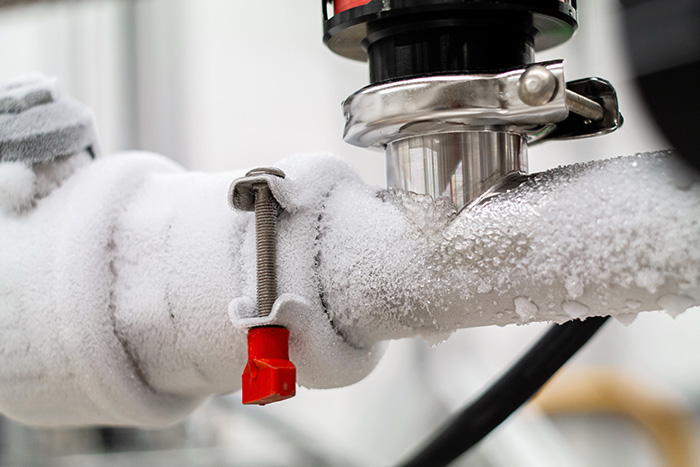Preventing Pipes from Cold Weather: Effective Methods
Preventing Pipes from Cold Weather: Effective Methods
Blog Article
Nearly everybody maintains their private thinking with regards to How to Prevent Your Pipes From Freezing.

Winter can damage your plumbing, specifically by freezing pipes. Right here's how to stop it from occurring and what to do if it does.
Intro
As temperature levels drop, the threat of frozen pipelines increases, possibly resulting in pricey repair work and water damages. Understanding just how to avoid icy pipelines is essential for home owners in chilly environments.
Comprehending Frozen Pipes
What creates pipelines to freeze?
Pipes ice up when subjected to temperatures below 32 ° F (0 ° C) for extended durations. As water inside the pipelines freezes, it increases, taxing the pipe walls and possibly triggering them to burst.
Dangers and problems
Frozen pipelines can cause supply of water disruptions, property damage, and pricey repair work. Ruptured pipelines can flooding homes and create extensive structural damages.
Indications of Frozen Pipeline
Identifying icy pipes early can prevent them from bursting.
Exactly how to determine frozen pipes
Search for reduced water flow from faucets, uncommon smells or noises from pipes, and visible frost on exposed pipes.
Prevention Tips
Shielding vulnerable pipelines
Wrap pipelines in insulation sleeves or make use of warmth tape to secure them from freezing temperature levels. Concentrate on pipelines in unheated or outside areas of the home.
Heating strategies
Maintain indoor areas appropriately warmed, specifically areas with plumbing. Open up cabinet doors to permit warm air to circulate around pipelines under sinks.
Protecting Exterior Plumbing
Yard hoses and exterior taps
Disconnect and drain garden tubes before winter months. Install frost-proof spigots or cover exterior faucets with protected caps.
What to Do If Your Pipelines Freeze
Immediate actions to take
If you believe frozen pipes, maintain taps open to ease pressure as the ice thaws. Use a hairdryer or towels taken in hot water to thaw pipes gradually.
Long-Term Solutions
Architectural modifications
Take into consideration rerouting pipelines away from exterior wall surfaces or unheated areas. Include additional insulation to attic rooms, basements, and crawl spaces.
Updating insulation
Invest in high-quality insulation for pipelines, attics, and walls. Correct insulation helps preserve regular temperatures and lowers the risk of frozen pipelines.
Verdict
Protecting against frozen pipes needs positive steps and quick responses. By recognizing the causes, signs, and safety nets, property owners can shield their plumbing during cold weather.
6 Proven Ways to Prevent Frozen Pipes and Protect Your Home
Disconnect and Drain Garden Hoses
Before winter arrives, start by disconnecting your garden hoses and draining any remaining water. Close the shut-off valves that supply outdoor hose bibs and leave the outdoor faucet open to allow any residual water to drain. For extra protection, consider using faucet covers throughout the colder months. It’s also important to drain water from any sprinkler supply lines following the manufacturer’s directions.
Insulate Exposed Pipes
Insulating your pipes is an effective way to prevent freezing. Pipe insulation is readily available at home improvement stores and is relatively inexpensive. Pay close attention to pipes in unheated areas such as the attic, basement, crawl spaces, or garage. Apply foam insulation generously to create a buffer against the cold. You can also wrap your pipes in heat tape or thermostat-controlled heat cables for added warmth.
Seal Air Leaks
Inspect your home for any cracks or openings that could let in cold air. Seal any holes around the piping in interior or exterior walls, as well as the sill plates where your home rests on its foundation. Additionally, make sure to keep your garage door closed unless you’re entering or exiting. Leaving it open creates a significant air leak that can lead to frozen pipes.
Allow Warm Air Circulation
During cold snaps, it’s essential to allow warm air to circulate evenly throughout your home. Leave interior doors ajar to promote better airflow. Open kitchen and bathroom cabinets to help distribute heat consistently around the rooms. If you have small children or pets, be sure to remove any household chemicals or potentially harmful cleaners from open cabinets for safety.
Let Faucets Drip
A small trickle of water can make a big difference in preventing ice formation inside your pipes. When temperatures drop significantly, start a drip of water from all faucets served by exposed pipes. This continuous flow helps prevent the water from freezing. Additionally, running a few faucets slightly can relieve pressure inside the pipes, reducing the chances of a rupture if the water inside does freeze.
https://choateshvac.com/6-proven-ways-to-prevent-frozen-pipes-and-protect-your-home/

Do you enjoy reading up on Helpful Tips to Prevent Frozen Pipes this Winter? Post a review further down. We would be delighted to know your reactions about this piece. We hope that you visit us again later on. Do you know about somebody else who is fascinated with Prevent Frozen Pipes ? Be sure promote it. Many thanks for being here. Please visit our blog back soon.
Customer Reviews Report this page